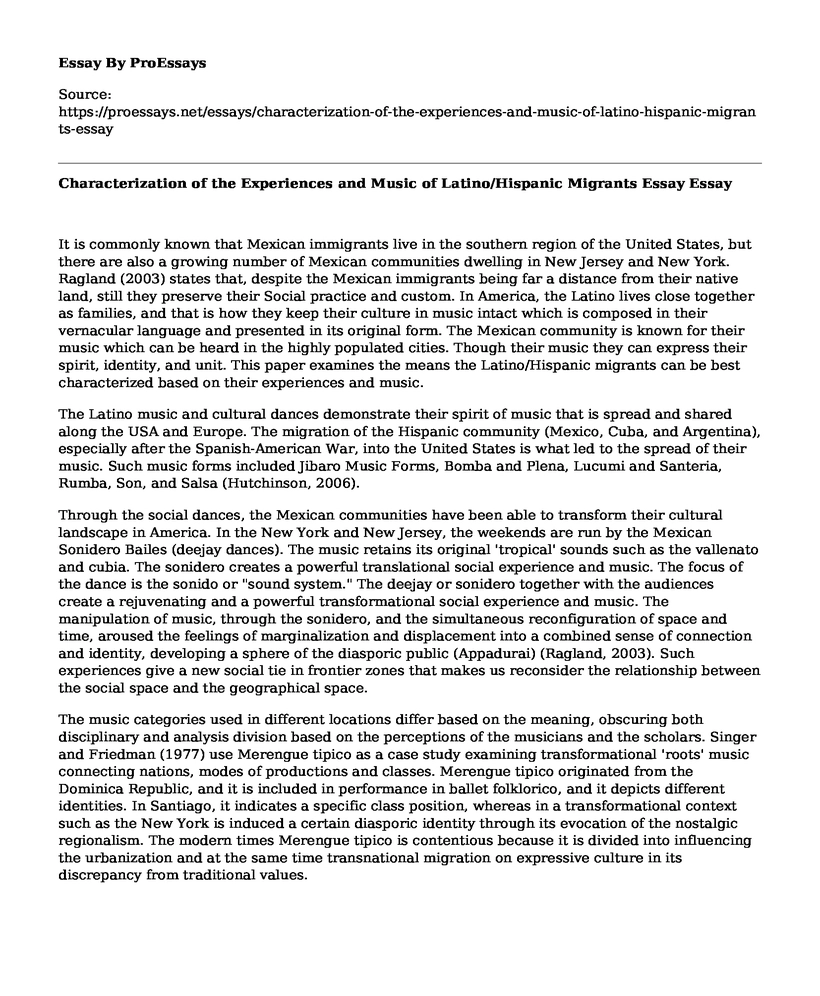It is commonly known that Mexican immigrants live in the southern region of the United States, but there are also a growing number of Mexican communities dwelling in New Jersey and New York. Ragland (2003) states that, despite the Mexican immigrants being far a distance from their native land, still they preserve their Social practice and custom. In America, the Latino lives close together as families, and that is how they keep their culture in music intact which is composed in their vernacular language and presented in its original form. The Mexican community is known for their music which can be heard in the highly populated cities. Though their music they can express their spirit, identity, and unit. This paper examines the means the Latino/Hispanic migrants can be best characterized based on their experiences and music.
The Latino music and cultural dances demonstrate their spirit of music that is spread and shared along the USA and Europe. The migration of the Hispanic community (Mexico, Cuba, and Argentina), especially after the Spanish-American War, into the United States is what led to the spread of their music. Such music forms included Jibaro Music Forms, Bomba and Plena, Lucumi and Santeria, Rumba, Son, and Salsa (Hutchinson, 2006).
Through the social dances, the Mexican communities have been able to transform their cultural landscape in America. In the New York and New Jersey, the weekends are run by the Mexican Sonidero Bailes (deejay dances). The music retains its original 'tropical' sounds such as the vallenato and cubia. The sonidero creates a powerful translational social experience and music. The focus of the dance is the sonido or "sound system." The deejay or sonidero together with the audiences create a rejuvenating and a powerful transformational social experience and music. The manipulation of music, through the sonidero, and the simultaneous reconfiguration of space and time, aroused the feelings of marginalization and displacement into a combined sense of connection and identity, developing a sphere of the diasporic public (Appadurai) (Ragland, 2003). Such experiences give a new social tie in frontier zones that makes us reconsider the relationship between the social space and the geographical space.
The music categories used in different locations differ based on the meaning, obscuring both disciplinary and analysis division based on the perceptions of the musicians and the scholars. Singer and Friedman (1977) use Merengue tipico as a case study examining transformational 'roots' music connecting nations, modes of productions and classes. Merengue tipico originated from the Dominica Republic, and it is included in performance in ballet folklorico, and it depicts different identities. In Santiago, it indicates a specific class position, whereas in a transformational context such as the New York is induced a certain diasporic identity through its evocation of the nostalgic regionalism. The modern times Merengue tipico is contentious because it is divided into influencing the urbanization and at the same time transnational migration on expressive culture in its discrepancy from traditional values.
Conclusion
Conclusively, through Latino music, they mediatize and dramatize their modern life experiences that oscillate between the United States and Latino countries. They develop modernity animated by imagined and real interpretations of history and culture, together with their mutual experiences of displacement and reinvention of their lives both as Americans and Hispanic as dual identity is formed. The Hispanic has revolved into different form reflecting their current lifestyles and modernization.
References
Hutchinson, S. (2006). Merengue tipico in Santiago and New York: Transnational regionalism in a neo-traditional Dominican music. Ethnomusicology, 50(1), 37-72.
Ragland, C. (2003). Mexican deejays and the transnational space of youth dances in New York and New Jersey. Ethnomusicology, 47(3), 338-354.
Singer, R., & Friedman, R. (1977). Puerto Rican and Cuban musical expression in New York'. Liner Notes to New World Records, 244.
Cite this page
Characterization of the Experiences and Music of Latino/Hispanic Migrants Essay. (2022, Dec 04). Retrieved from https://proessays.net/essays/characterization-of-the-experiences-and-music-of-latino-hispanic-migrants-essay
If you are the original author of this essay and no longer wish to have it published on the ProEssays website, please click below to request its removal:
- The Role of Social Media in Peoples Revolution
- Research Paper on Obesity in Children, Michigan
- Film Analysis Essay on Invasion USA (1952) and Cold War Culture
- 3 Generations of Mass Media: Past, Present & Future - Essay Sample
- Family Gatherings: Memories and Celebrations from Grandma's Home - Essay Sample
- Essay Example on Spotify: From Piracy to a Billion-Dollar Music Streaming Giant
- Moral Issues of War Police and Terrorism in America - Free Paper Example







